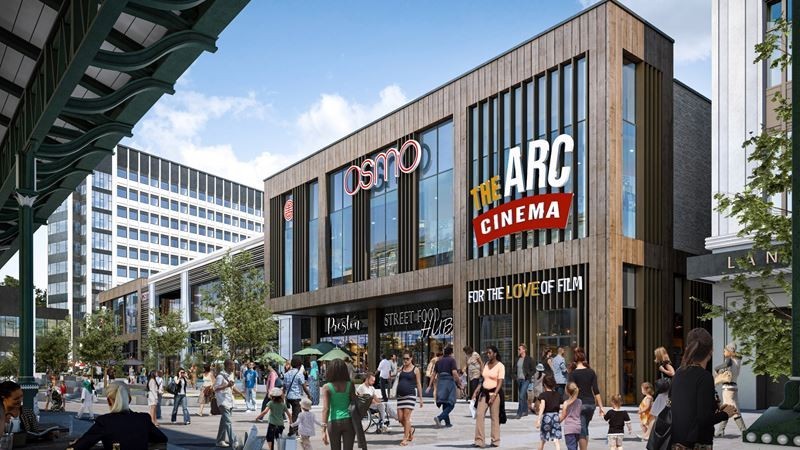Soaring inflation and construction costs are building pressure on Lancashire levelling up projects and challenging the viability of commercial developments.
Preston’s flagship Animate scheme in the city centre is a prime example of the impact being felt on regeneration. The cinema and leisure complex will now cost £45m to deliver - up from the £41m estimated when it received planning permission last March.
The city council has also revealed the big squeeze being felt on other projects – forcing it to cut back on some, seek more funding and borrow money to keep Preston’s regeneration moving forward.
Leading figures in the county’s property and construction sector have also told Lancashire Business View how rising inflation and falling investor confidence has added to the strain of material price volatility.
Adrian Philips, chief executive at Preston City Council, says spiralling costs are a major challenge to its city centre regeneration work.
That has meant cutting back on a Towns Fund scheme to improve the public realm.
He says: “We have had to reduce things significantly because of cost inflation. The price of some specialist materials has gone up 20-30 per cent.
“It was a case of biting the bullet and reducing the footprint of the scheme to focus on priority areas. It is disappointing but this is the real world.”
In some projects ‘value engineering’ has been implemented to reduce costs. Adrian says: “Sometimes it can be quite brutal.”
The council has also had to borrow money for the regeneration of the Grade-II listed Amounderness House – part of its Harris Quarter vision – to ensure it goes ahead.
The £7.4m scheme is one of six major projects planned under Preston’s Harris Quarter Towns Fund Investment Programme, for which the city received £20.9m from the government’s Towns Fund in March 2021.
And it has had to seek further funding for the refurbishment of the city’s iconic Harris museum, library and art gallery, with scaffolding among the rising costs. The council has also put more of its own money into the project.
In February this year, Preston was awarded £20m of levelling up cash to regenerate its parks. It’s a substantial sum but the challenges of cost inflation remain.
Adrian says the government has made it clear that councils can’t go back for more money to mitigate the impact. He says: “We put the levelling-up bid last summer and things have changed a lot since then. It is a question of being as flexible as possible.
“Things are moving forward, it is just more difficult. The last thing we want is for things to falter, stall or be significantly delayed. It is about making pragmatic decisions.”
Tim Webber is managing director of Lancashire-based construction and development group
Barnfield. He says: “There is no doubt 2022 was a challenging year for main contractors in terms of controlling rising costs from suppliers and subcontractors alike.
“Values within both the residential and industrial sectors continued to rise through most of 2022, which helped balance the increase in costs. However, within the last quarter of 2022, the end values dipped and flattened out causing a huge imbalance. It is vital to control costs as we go into 2023.”
Tim adds: “It is certainly challenging making projects financially viable in a market of rising costs, however in the early weeks of 2023 we have seen suppliers and subcontractors chasing work.
“This could be the first indication of a market slowdown, which will help bring costs down, but we wait to see how further pressure of both wage and energy rises manifests itself in the construction sectors.
“In 46 years of business we’ve seen these trends many times before and we remain in a strong and stable position to weather this storm.”
Jeremy Hartley, managing director of the Eric Wright Group, another major Lancashire construction and development business, says the impact of rising costs and inflation is making it more difficult to get developments out of the ground.
He says: “Viability is constantly being challenged and this is particularly the case in the commercial property sector. Rising costs are combining with increased interest rates and reduced market investor confidence.
“We’re working collaboratively with clients and subcontractors to ensure there is a degree of future-proofing on every project and to factor in an allowance wherever possible. We operate an ‘open book’ policy with our clients to give full visibility and as much cost certainty as we can.”
He adds: “On projects that are in the early stages, or which have not yet begun, we are liaising with our clients to provide them with the opportunity to make early commitments and avoid more significant price hikes wherever possible.
“On live projects we continue to work with our supply chain partners to ensure that procurement and commitments are made at the earliest possible stage taking steps like storing materials on site in some instances, well in advance of the date that they are actually required.
“The cost of finance is showing signs of levelling off or even reducing in the medium term although it’s hard to see it reducing to previous levels given the political turmoil of 2022.”
Jeremy says there has been some settling down on general pricing since last year but believes the issue will continue to impact throughout 2023 and adds: “We are not yet on the home straight.”
He says: “We are being increasingly careful with how capital is used to maintain our financial resilience in uncertain times. New business cases are being more thoroughly tested from all angles before embarking on ventures.
“The group is focused on mitigating issues around pricing strategies and meeting the current unprecedented inflationary pressures as successfully as possible.
We aim to ensure that we do not take on any undue risk and continue to carefully consider and evaluate the deliverability of every new project.”
Michael Conlon, chairman of Conlon Construction, which has its HQ in South Ribble, says a “myriad of challenges” have played a part in rising costs. He cites the war in Europe, which led to sanctions cutting off timber supplies from Russia, energy hikes sparking increases in the price of cement, plaster, bricks, tiles and steel, and the cost-of-living crisis.
Michael says: “Clients have often budgeted years in advance, but costs are now higher, forcing delays and, in some cases, the cancellation of projects.
“As a sector we need to drive on. Many professionals, even some in senior roles, will not have encountered double digit inflation before. It is important to stress, therefore, that time is not on a client’s side if they choose to delay.
“Time spent attempting to find savings may perversely have the opposite effect precisely because of the impact of high inflation.”
Housebuilding has also been affected. Joel Winders, commercial director at Lancashire developer Kingswood Homes, says: “We anticipate price rises to continue throughout 2023 albeit at a slower pace than previous years, but this coupled with a predicted levelling off in house price growth in 2023, presents a tough challenge for the industry.
“We are predicting a decrease in housing numbers for our next financial year in the region of 20 per cent when compared against our current forecast. We are well placed and resilient to any potential changes in the market given our strong land bank and funding partnership with Homes England.”
David Robinson is managing partner at Preston headquartered architecture, design and masterplanning practice FWP. Project and cost management are among its disciplines, and he sees the industry is likely heading into “calmer waters” towards the end of 2023.
David says industry data indicates that construction inflation, moving forward, should be well below the RPI inflation level. He says: “That would suggest there is a calming as some raw materials are stabilising in cost.
“The last year or so has been quite volatile as contractors have had to contend with an unpredictable situation in terms of fixing material or subcontractor prices. The pressure has been on, when it comes to starting projects and whether to go now or have another look at the financial viability.”
He adds: “Striving to achieve cost certainly is a key issue in all the projects that FWP is involved in.”
Enjoyed this? Read more from Ged Henderson























